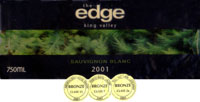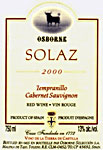|
Recent Articles |
|
|
|
Get
all the evaluations for
the April
Release National Post Weekly Wine & Spirits Columnist Saturday, February 22, 2003 There is no question that the thought of
becoming a wine agent sounds great. All those great tasting trips
abroad, free samples galore and endless write-offs. Unfortunately, there
is one major stumbling block: the LCBO’s monopoly of retail sales,
which for some, seems as impenetrable as the Berlin Wall. And yet, almost everyday, brave folks are
prepared to take the plunge - setting up importing companies with
visions of LCBO listings and restaurant sales dancing in their heads.
Indeed, the discovery that anyone can get into this business with almost
no money down has lured hundreds of innocents, like moths to the flame,
into the agency game. Today, there are more than two hundred
registered agents in Ontario. Many are completely invisible with just a
few items for sale usually related to their vacations and/or business
trips abroad. These are people who enjoy wine and want to share their
love affair with fellow Ontarians. Unfortunately, the economics of such
small “one man bands” is such that they become easy prey to larger
companies after launching commercially viable products. Then there are the wine specialists. Their
portfolios vary from pricey, obscure, highly sought-after, California
boutique wines to those who focus on say, the great values from southern
France. Many of these dedicated folks are to be commended for expanding
our vinous horizons by pressing the LCBO and licensees into buying their
undiscovered gems from far away places. Unfortunately, this window of
opportunity has been virtually closed since 1997 due to the LCBO’s
failure to increase consignment-warehousing space for the multitudes
waiting to get in. At the very top of the pyramid you find the
corporate giants, usually big booze companies, whose wine portfolios are
usually no more than forlorn footnotes at the bottom of their list of
offerings. Here the boardroom takes precedence. Visiting wine producers
are often ignored and left to fend for themselves. For these boardroom
boys, it all boils down into mainstream core listings, the number of
bottle facings and big buck spending at the LCBO. Missionary work
associated with consignment and/or private sales is basically of no
interest.
His first foray into the agency business
was at McGuiness Distillery in 1958 - a job that lasted 21 years, until
he and George Lubienski launched PMA with the financial assistance of
Germany’s most famous distiller Emile Underber in 1979. Three years later, Mielzynski ventured
forth and coordinated the acquisition of the Niagara-on-the-Lake Newark
Winery for Underberg. At a time when Canadian whites were outselling
reds by 3 to 1, they launched the German-inspired Schloss Hillebrand.
Within 10 years, the now-named Hillebrand Estates winery had opened more
than 40 of its own stores and realized LCBO sales of over 90,000 cases
(a 20-fold increase) based on 22 general listings. In 1994 Hillebrand
was sold to Joe Peller of Andres. Now one might think that was the end of the
story, but that wasn’t in the cards. Mielzynski now focused on
developing his own PMA product line - building up a dynamic portfolio to
challenge the corporate giants. Never to miss
a beat, last fall while celebrating 24 years in the agency business,
Mielzynski capitalized on distillery director Sally
Grant Gordon’s visit to Toronto
to present a series of special gifts of 24-year-old Glenfiddich. “Being visible is one of the keys to
keeping our sales alive and healthy,” states Mielzynski. Of course, no
amount of glad-handing can succeed in the
long run without a good portfolio. And this is where folks at PMA shine.
For not only do they handle Canada’s biggest selling single malt, as
well as 15 and 22-year-old The Balvenie which will be appearing in
upcoming Vintages releases. Add to that an enormous list of spirits and
liqueurs – including sublime Jamaican rums from Appleton Estate and
Wray & Nephew, Skyy Vodka, Grand Marnier, Boulard Calvados, Ouzo 12,
and of course, for old time sake, Polish Luksusowa Potato Vodka. While Mielzynski admits to not being as
active as in the past, he credits his son and company President, Peter D. Mielzynski as the new
designated workhorse. “It’s the team effort that makes our growth
possible,” says his son, adding that “it’s essential to get our
products out in front of the customer, as well as the critic.” This year’s April 1st
Chairman’s Gala, for instance, will feature some sixty special
consignment, private order and Vintages wines, along with a few classic
spirits. Hang on to your hats because their fine wine specialist Todd
McDonald plans to open a bottle of 1863 Offley Vintage Port
– yes 1863, not 1963.
Technically speaking, this is a Vino de la Tierra de Castilla,
which was only designated in 1999. The 600 ha of family-owned
Tierra de Castilla vineyards are located in the province of Toledo just
southwest of Madrid. For the record, this 1.028 ha single estate is the largest viticultural
project of its kind in Europe. Current/Upcoming
events
include the Ontario-focused Cuvée 2003 Gala Evening (featuring 40 wineries and eight chefs) on Friday,
February 28th. Tickets are $175 per person. Contact Grey
Gables School at 905-685-4577 or 1-800-263-5766 (White Oaks Resort) or www.greygablesschool.com. Dropped in last week to savour the “hedonism and indulgences of Mardi Gras” at The Fairmont Royal York’s EPIC Restaurant, which continues through to Friday, February 28. This is part of the Fairmont’s the “World of Chefs Series” and features Chef David Adcox who promised to bring to EPIC an exotic menu featuring New Orleans’ Cajun and Creole cuisine.
Check out the
| ||
|
Copyright Food & Beverage Testing Institute of Canada
2004 |

 Between
the specialists and the conglomerates is a range of medium to large
sized firms competing hard for their share of the market. These various
agency configurations came to mind recently when an invitation turned up
from one of Ontario’s elder statesmen in the import agency business:
Between
the specialists and the conglomerates is a range of medium to large
sized firms competing hard for their share of the market. These various
agency configurations came to mind recently when an invitation turned up
from one of Ontario’s elder statesmen in the import agency business:  McDonald flaunted a terrific Sauvignon
Blanc at a recent dinner. It was surprisingly fleshy with lots of gently
grassy, ripe pear and crisp melon fruit flavours. “A fine New Zealand
effort,” I thought to myself – but no -
McDonald flaunted a terrific Sauvignon
Blanc at a recent dinner. It was surprisingly fleshy with lots of gently
grassy, ripe pear and crisp melon fruit flavours. “A fine New Zealand
effort,” I thought to myself – but no -  Fortunately
you don’t have to be a millionaire to find excellent value on the PMA
list. My best buy red of the week, for instance, costs a mere $9.45 on
the LCBO general list. Make way for the
Fortunately
you don’t have to be a millionaire to find excellent value on the PMA
list. My best buy red of the week, for instance, costs a mere $9.45 on
the LCBO general list. Make way for the  The
dishes sampled from the evening menu seemed competent and pleasing,
Personally, however, I didn’t find them overly innovative or even
especially classic in style. My dining partner was more enthusiastic,
especially about her Pork Chop Paulette ($32). The crispy crab cake amuse
bouche was definitely a highlight. Unfortunately, it seems that good
old Toronto simply doesn’t have a supply of the real ingredients to
cut the mustard – no genuine Louisiana red snapper, speckled trout,
Gulf on Mexico white shrimp, ditto for the spices or real taso ham.
While the Rye-based
The
dishes sampled from the evening menu seemed competent and pleasing,
Personally, however, I didn’t find them overly innovative or even
especially classic in style. My dining partner was more enthusiastic,
especially about her Pork Chop Paulette ($32). The crispy crab cake amuse
bouche was definitely a highlight. Unfortunately, it seems that good
old Toronto simply doesn’t have a supply of the real ingredients to
cut the mustard – no genuine Louisiana red snapper, speckled trout,
Gulf on Mexico white shrimp, ditto for the spices or real taso ham.
While the Rye-based